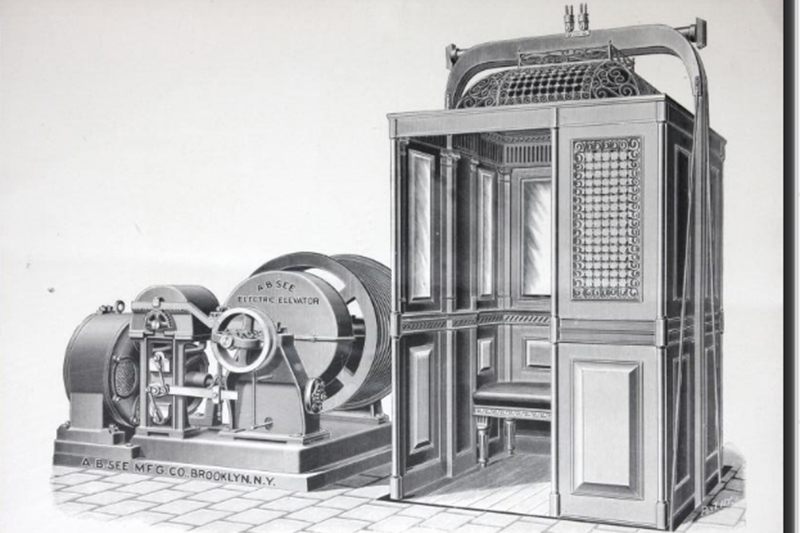This post is part of a monthly series that explores the historical applications of building materials and systems through resources from the Building Technology Heritage Library (BTHL), an online collection of AEC catalogs, brochures, trade publications, and more. The BTHL is a project of the Association for Preservation Technology, an international building preservation organization. Read more about the archive here.
While the construction of the skyscraper is rightly attributed to advances in steel-frame technology, the ability to utilize a skyscraper’s multistory space must be credited to another innovation altogether—the elevator.
Preceded by pulley and platform systems used in material-extraction industries such as mining, initial elevator models were powered by hand, steam, or hydraulics and were utilized primarily in small-scale commercial and warehouse environments. Eventually passenger elevators became more popular and the electrification of modern buildings created an ideal market for the building ascension technology.
From the first passenger elevator, installed in 1857, to the introduction of elevators for residential applications, the BTHL chronicles the evolution of elevator technology and design.
The First One Hundred Years, Otis Elevator Co., New York, 1953
The 1953 Otis Elevator catalog was issued in honor of the company’s 100th anniversary, chronicling its elevators’ first century of use. Major advances include the first push button elevator, the creation of the first elevator inspection service, and the first operator-less elevators.
Morse, Williams & Co., Builders of Passenger and Freight Elevators of Every Description, Philadelphia, c. 1880
As the oldest elevator catalog in the BTHL, this publication showcases side-post freight elevator platform technology for which the lift mechanism is powered by a belt-powered screw hoist.
Illustrated catalogue of the J. W. Reedy Elevator Manfg. Co. : Passenger & Freight, Steam, Hydraulic and Handpower Elevators, New York and Chicago, 1890
This 19th-century elevator catalog features three competing power system technologies for elevator operation: steam, hydraulic and hand-powered. Hand-powered systems were particularly popular for commercial and industrial uses.
A. B. See Electric Elevator Co., Brooklyn, N.Y., c. 1901
This catalog advertises electric elevators for residential applications along with an exhaustive list of office and loft buildings in New York where they are installed.
Otis, Otis Elevator Co., New York, 1903
Elijah Otis—founder of the Otis Elevator Co.—is best known for his safety-improving innovations for elevators in the 19th century. This catalog outlines available electric elevator options that do not require an attendant and are outfitted with push-button control systems. At this point, Otis still offered hydraulic-, plunger-, and steam-powered operating systems.
Electric Traction Elevators, Kaestner & Hecht Co., Chicago, 1915
The Kaestner & Hecht Co. offered electric traction elevators with four types of traction gears that building owners could specify based on their service needs. Kasetner & Hecht claimed that its technology offers the “highest degree of safety and economy.”
Moving Your Customers and What They Buy: Brief Suggestions for Increasing Business by Improving Service, Otis Elevator Co., New York, 1915
This specialty catalog for retail businesses promotes a range of products including elevators, escalators, dumb waiters, and “gravity spiral conveyers,” to improve circulation, accessibility, and convenience in stores. “Equipment performs the double function of drawing customers and retaining customers,” according to the publication.
Otis Hand Power Elevators, Otis Elevator Co., New York, 1920
Though many structures in the United States were already powered by electricity at the time this catalog was published, hand-powered elevators were a cheaper—and therefore popular—option for small businesses and warehouses.
Elevator Fronts and Cars, Cincinnati Manufacturing Co., Cincinnati, c. 1930
This catalog provides design options for elevator doors in various materials, including bronze and steel, and with options for different window configurations. Buyers can also specify color finishes, molding styles, wood grain finishes, and light fixtures.
Tyler, W. S. Tyler Co., Cleveland, Ohio, 1938
W.S. Tyler Co. offered architectural metal applications for elevator doors and cars in Art Deco and Modern styles. The company also sold various accessories including attendant seats, embellished railings, and ornamental iron and bronze work.
Residence Elevators: “Elevette” Inclin-ator, Inclinator Co. of America, Harrisburg, Pa., c. 1940
This catalog highlights a residential, single-channel elevator called the “Elevette” specifically created for construction adjacent to a staircase, in a closet, or for a small corner.
Rotary Oildraulic Elevators, Rotary Lift Co., Memphis, Tenn., 1948
Suited for “extremely heavy-duty applications,” according to this publication, Rotary oildraulic elevators were supported by a column of oil with cars that were pushed from below rather than pulled from above. These units could reach a speed of 100 feet per minute.
